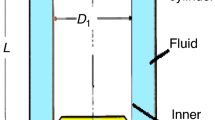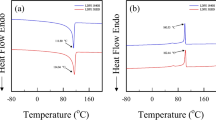Abstract
To study the overall rheological characteristics of the silicone oil-based ferrofluid, a chemical co-precipitation method was adopted for preparation, and transmission electron microscopy (TEM) and vibrating sample magnetometer (VSM) were used for characterization. The average size of Fe3O4 magnetic particles was 10.4 nm and the saturation magnetization of the ferrofluid was 5.98 emu/g. Then, the fluidity, magnetoviscous effect and viscoelasticity of the ferrofluid were studied using a rotational rheometer. The results showed obvious shear thinning of the silicone oil-based ferrofluid under an external magnetic field, and the yield stress of the ferrofluid could not be accurately obtained by fitting the flow curve with an H–B model at a continuous shear rate. A strong magnetoviscous effect could be observed at different shear rates and temperatures. The magnetoviscous parameter R increased with the increase of temperature and its variation decreased with the increase of shear rate. Moreover, based on the magnetic particle chain model and the viscosity–temperature characteristics of the base carrier liquid, different mechanisms of temperature influence on the magnetoviscous effect were analyzed. Finally, a discussion of the microstructure evolution mechanism of the ferrofluid in the modulus changing with frequency was presented through the viscoelastic analysis of the silicone oil-based ferrofluid.












Similar content being viewed by others
Data availability
The data that support the findings of this paper are available from the corresponding author upon reasonable request.
References
Odenbach S (2003) Ferrofluids—magnetically controlled suspensions. Colloids Surf A 217(1–3):171–178
Odenbach S (2009) Colloidal magnetic fluids: basics, development and application of ferrofluids. Springer
Ashtiani M, Hashemabadi SH, Ghaffari A (2015) A review on the magnetorheological fluid preparation and stabilization. J Magn Magn Mater 374:716–730
Cui H, Li D (2019) Fabrication and properties research on a novel perfluoropolyether based ferrofluid. J Magn Magn Mater 473:341–347
Li RN, Da XH, Li X et al (2021) Functionalized magnetic nanoparticles for drug delivery in tumor therapy. Chin Phys B 30(1):017502
Yamaguchi H, Iwamoto Y (2017) Energy transport in cooling device by magnetic fluid. J Magn Magn Mater 431:229–236
Li ZK, Yao J, Li DC (2017) Research on the rheological properties of a perfluoropolyether based ferrofluid. J Magn Magn Mater 424:33–38
Rosensweig RE, Kaiser R, Miskolczy G (1968) Viscosity of magnetic fluid in a magnetic field. J Colloid Interface Sci 29(4):680–686
Shliomis M (1971) Effective viscosity of magnetic suspensions. Zh Eksp Teor Fiz 61(2411):s1971d-1971
Pinho M, Brouard B, Génevaux J-M et al (2011) Investigation into ferrofluid magnetoviscous effects under an oscillating shear flow. J Magn Magn Mater 323(18–19):2386–2390
De Gennes P, Pincus P (1970) Pair correlations in a ferromagnetic colloid. Physik der kondensierten Materie 11(3):189–198
Zubarev AY, Odenbach S, Fleischer J (2002) Rheological properties of dense ferrofluids effect of chain-like aggregates. J Magn Magn Mater 252:241–243
Ruiz-López JA, Fernández-Toledano JC, Klingenberg DJ et al (2016) Model magnetorheology: a direct comparative study between theories, particle-level simulations and experiments, in steady and dynamic oscillatory shear. J Rheol 60(1):61–74
Wang ZW, Shahrivar K, de Vicente J (2014) Creep and recovery of magnetorheological fluids: experiments and simulations. J Rheol 58(6):1725–1750
de Vicente J, Berli CL (2013) Aging, rejuvenation, and thixotropy in yielding magnetorheological fluids. Rheol Acta 52(5):467–483
Han SD, Cui HC, Zhang ZL et al (2021) Preparation of magnetic fluids and introduction of several special magnetic fluids. J Funct Mater 52(10):10061–10068
Chen HJ, Wang YM, Qu JM et al (2011) Preparation and characterization of silicon oil based ferrofluid. Appl Surf Sci 257(24):10802–10807
Bai L, Zhang ZL, Xu LF et al (2017) Preparation and performance studies of Fe3O4@SiO2 silicone oil based magnetic fluid. J Funct Mater 48(11):11103–11107
Li WY, Zhang ZL, Li DC (2019) Rheological properties of silicon oil-based magnetic fluid with magnetic nanoparticles (MNPs)-multiwalled carbon nanotube (MWNT). Smart Mater Struct 28(6):065023
Hong RY, Ren ZQ, Han YP et al (2007) Rheological properties of water-based Fe3O4 ferrofluids. Chem Eng Sci 62(21):5912–5924
Jung ID et al (2016) A comprehensive viscosity model for micro magnetic particle dispersed in silicone oil. J Magn Magn Mater 404:40–44
Poulos AS, Stellbrink J, Petekidis G (2013) Flow of concentrated solutions of starlike micelles under large-amplitude oscillatory shear. Rheol Acta 52(8–9):785–800
Koumakis NA et al (2012) Direct comparison of the rheology of model hard and soft particle glasses. Soft Matter 8(15):4271–4284
Zhao P, Li X, Tong Y et al (2021) Effect of the interface between magnetic particles and carrier liquids on magnetorheological properties and sedimentation of magnetorheological fluids: a molecular dynamics simulation and experimental insights. J Mol Liq 342:117377
Li ZK (2019) Study on the rheological property of magnetic liquids and its influence on sealing fluids performance [D]. Beijing Jiaotong University
Zubarev AY, Fleischer J, Odenbach S (2005) Towards a theory of dynamical properties of polydisperse magnetic fluids: effect of chain-like aggregates. Physica A 358(2–4):475–491
Felicia LJ, Vinod S, Philip J (2016) Recent advances in magnetorheology of ferrofluids (magnetic nanofluids)—a critical review. Journal of Nanofluids 5(1):1–47
Dong HB, Han WJ, Gao CY et al (2018) Preparation and magnetorheological response of triangular-shaped single-crystalline magnetite particle-based magnetic fluid. IEEE Trans Magn 54:1–4
Funding
Fundamental Research Funds for the Central Universities, 2022JBMC032, Natural Science Foundation of Beijing Municipality, 2222072, Foundation of Key Laboratory of Vehicle Advanced Manufacturing, Measuring and Control Technology (Beijing Jiaotong University), Ministry of Education, China,M21GY1300050, National Major Instrument Research and Development Program of Natural Science Foundation of China, 51927810.
Author information
Authors and Affiliations
Corresponding authors
Ethics declarations
Conflict of interest
All authors certify that they have no affiliations with or involvement in any organization or entity with any financial interest or non-financial interest in the subject matter or materials discussed in this manuscript.
Additional information
Publisher's Note
Springer Nature remains neutral with regard to jurisdictional claims in published maps and institutional affiliations.
Rights and permissions
Springer Nature or its licensor (e.g. a society or other partner) holds exclusive rights to this article under a publishing agreement with the author(s) or other rightsholder(s); author self-archiving of the accepted manuscript version of this article is solely governed by the terms of such publishing agreement and applicable law.
About this article
Cite this article
Zhang, J., Cui, H., Han, S. et al. Research on the rheological properties of a silicone oil-based ferrofluid. Korea-Aust. Rheol. J. 35, 179–190 (2023). https://doi.org/10.1007/s13367-023-00065-y
Received:
Revised:
Accepted:
Published:
Issue Date:
DOI: https://doi.org/10.1007/s13367-023-00065-y




